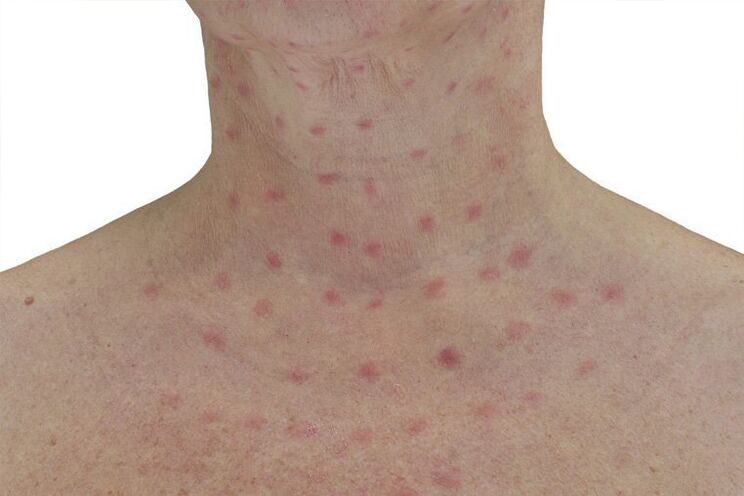
It is known that various neoplasms on the skin in many cases are caused by human papillomavirus.Today, more than 600 strains of pathogens have been identified.Some cause the appearance of warts, others - condyl, others can cause malignant tumors.That is why, before removing the neoplasm in the cosmetic salon, you need to undergo an exam by a dermatologist.
The cause of papilloma occurs
It is believed that human papillomavirus is infected up to 70% of the population of the planet.Often, according to the results of the analysis, it is clear that a person is infected immediately with 20 strains of viruses.But often the virus does not show itself for a long time, especially if one has good immunity.
Infections by any HPV strains are more frequent with direct contact with the carrier of the virus, where pathogens can penetrate the microtrauma on the skin and mucous membranes.Neoplasms are formed directly at the area of virus penetration into the body.Anogenital forms of the disease are spread during intercourse, in this case, papules are formed in the folds of the throat skin, on the vaginal and cervical mucous membranes, in the rectum, urethra and bladder, and in men in the head of the penis.Outside, pointed condiloma is mainly formed, and on the internal organs - flat papilloma.In the same way, the oral cavity can be infected.In this case, laryngeal papillomatosis occurs, which affects the mucous membranes of the mouth and throat.
A newborn can be infected with HPV from a mother during the birth channel.At the same time, the most common anogenital papillomatosis in children, the most aggressive tension, or laryngeal, which can damage the voice of the children in the future and even endanger life in severe cases due to respiratory tract obstruction.
However, to infect HPV, it is not necessary to contact the carrier directly.The virus can exist for some time outside the carrier body and delivered through household goods or in public.In short, sometimes it is enough to hold hands in public transport, and then touch the face for one or two years, neoplasms appear in this place.
Since the papillomavirus incubation period is quite long, from the time of infection to the appearance of clinical signs, several months or even years can pass.The virus is usually activated and begins to manifest itself in the form of neoplasms when immunity is reduced.That is why treatment should include not only the removal of visible HPV manifestations, but also systemic immune therapy.

The type of neoplasms caused by HPV
Not all clinical manifestations of papillomatosis are the same.Today, about 90 HPV strains are marked and correlated and associated with certain types of neoplasms.According to the external manifestation of the disease, the following types of papilloma are distinguished:
- Plantar papillomas, often called warts;
- simple, or coarse, papillomas;
- flat papillomas;
- spicy condylomas;
- Movie papillomas.
Subanary warts
As the name implies, plantar warts are formed on the scalp and characterized by internal growth, which distinguishes them from other types of neoplasms.They are usually single, but without treatment, they can reach an impressive size, causing great discomfort.
Papillomas Vulgar
Vulgar papillomas are also often called warts in everyday life.They grow from small tubercle, gradually increasing and darkening because of keratinization, can join each other in uncertain forms.This type of papillomas is most often localized on the skin, less frequently on the knees, face, neck, back.Like plantar, they can happen on their own.
A flat papillomas
The flat papillomas rise slightly above the skin, and the surface has a nodular structure.These neoplasms are not vulnerable to keratinization (keratinization) of the surface, so they usually maintain a healthy tissue color or become darker.They can appear on the face in the eyes and chin, as well as on the lower leg, arms, back.Itching is a symptom of coarse papilloma.Such neoplasms themselves do not pass, and doctors should make the right diagnosis.
Sharp condylomas
Sharp condiloma in appearance is similar to cauliflower.Single neoplasms grow on thin feet, gradually combining with each other into huge growth.Condylomas are located in the Anogenital region:
- on external and internal genital organs;
- Outside and inside the anus;
- in perianal folds;
- In the urethra and bladder.
These neoplasms are premature, and are therefore subject to mandatory removal with subsequent therapy according to the test results.It is enough to say that with cervical cancer in almost 80% of cases, this type of human papillomavirus reveals.

The papillomas of the movie
Papillomas of the film, instead called acrochics, grow on thin feet, which is why they are easy to tear, and especially single, less often found in groups.The main places of their localization are the faces of the eyes and nose, inguinal folds, the axillary area and under the women's chest.Usually they have oval, elastic shape without keratinization.With friction, clothing can cause discomfort and damage.Acrochords cause aesthetic discomfort primarily and are subject to violence in rare cases.
Diagnosis of papillomas
No matter how much you want to get rid of boring papilloma faster and at home, and better - with the help of some folk remedies, don't rush!The selection of independent procedures can lead to sad results.Be sure to visit the District Clinic.
In paid clinics, for your money, they will cut you/burn/freeze anything without unnecessary questions, but there is no guarantee to make the right diagnosis, and therefore lack of unwanted consequences.
Only qualified specialists can make the right diagnosis and prescribe appropriate treatment.Be sure to submit the test prescribed by the doctor before removing the neoplasm.First of all, you need to get a consultation:
- gynecologists or urologists when neoplasms appear in the perineum;
- otolaryngologists if suspected papillomatosis of mucous membranes or throat;
- Dermatology - in all other cases.
Based on the results of the clinical examination, the doctor may prescribe if necessary:
- Cells for cytological research;
- tissue fences for histology;
- scraping PCR analysis;
- Material fence for Digi-Test.
All of these methods in one way or another allow you to determine the risk of onkopathological development.After removing the neoplasm with any method, this indicator is not possible to determine.In this case, the possibility of adverse effects increases.
How to remove papilloma
The choice of papilloma removal method depends on the diagnosis and localization of the neoplasm.

The destruction of the chemical
It is carried out using a special liquid drug based on acid or cream containing alkali.The drug is sold in pharmacies as a doctor.
This method can be used to remove only single vulgar papillomas (warts) in hand.
However, little inaccuracy in the use of chemotherapy can lead to healthy tissue burning or incomplete removal of neoplasms.The use of such tools is painful, takes a lot of time, does not provide guaranteed results and can lead to the formation of unaesthetic scars in the neoplasms.
Cryodestruction
It is a long and good method for removing neoplasms using exposure to very low temperatures, where defeat for a short time acts with liquid nitrogen or other refrigerants.
Cooling appliances do not require early anesthesia, as the application is not painful, although the patient may feel a bit of tingling or burning.However, after surgery, during "removing" the cloth, acute pain occurs, which can last up to a day.This is a common phenomenon.
After a few hours, redness and swelling are formed around damage, and subcutaneous bubbles filled with fluid are formed after a day.The recovery period lasts a week, in which edema and hyperemia disappear, and its own bubbles break.After that, it is necessary to apply the antiseptic drug prescribed by the specialist.
The death of the fabric under the river persists for three weeks, which ensures the destruction of the infected tissue.The wound healing takes place within 1.5 months, and the trace completely disappears for six months, where it is necessary to protect the skin from the sun and mechanical exposure.
This method is successfully used to remove papilloma on the body, in the oral cavity and for cervical treatment.But to remove neoplasms in the face and in intimate zones, it is best to use other methods.In the first case - due to edema and hyperemia, in the second place - due to increased pain sensitivity in the genital area.
Freezing of radio waves
Removing with radio -short neoplasms occurs under the influence of high frequency radiation directed, where the affected tissue evaporates.Devices for radiotherapy have several electrodes of various shapes and purposes, selected by the doctor depending on the form of neoplasms.
This procedure occurs under local anesthesia in the form of injections.With this method, papilloma is released quickly, without damage to healthy tissue, almost leaving no trace.There is no recovery period here, but there are many contraindications to the use of this method.Radio -Note is contraindicated in:
- worsening chronic illness;
- acute inflammation process;
- Diabetes mellitus;
- pregnancy and breastfeeding;
- presence of heart paceming tools;
- Any oncology disease -where localization.
You cannot use radio wave treatment if there is a possibility of malignant papilloma.But if not, this method is successfully used anywhere in the body.According to the patient, the most unpleasant in this procedure is anesthetic injection.
Freezing of laser
Modern -free ways to get rid of neoplasms using lasers are broad not long ago.Experts claim that he is true -is actually painless and low -traumatic, because infected tissue evaporates without damaging healthy.The procedure takes a few minutes, and the recovery period lasts for 2 weeks, where you should refrain from swimming in the pool and open reservoirs, avoiding temperature and sun changes.
This method can cause side effects in the form of skin redness and prolonged edema, with thyroid problems, keloid scars can be formed.There are many contraindications for this type of treatment:
- Diabetes mellitus;
- acute inflammation process;
- epilepsy;
- violations of the endocrine and immune system;
- Photodermatosis;
- Thrombocytopenia and others.
According to the patient, the procedure is very unpleasant and painful, and in the process there is a smell of flesh."In addition, long and relapse healing is possible.

Electrocoagulation
It is used to remove small papilloma.Because the essence of this method lies in the destruction of the thermal of the affected fabric, the people are the name "Cauterization".The heated electrode touches the neoplasm and executes it along with the vessel, as a result of the formation of the point, which is covered with dark crust within an hour.In the case of a single papilloma, local anesthesia is used, and with a variety of small neoplasms it is not suitable.
The recovery period lasts a week, where redness and swelling, and dark crust falls.Currently, it is recommended to keep the sun and treat the skin with antiseptic.
The use of this method is possible for any localization of neoplasms, and patients' reviews show its reliability.At a very democratic price for the elimination of one papilloma, the removal of various neoplasms will cost a penny.


















